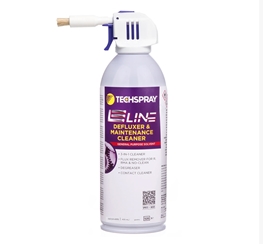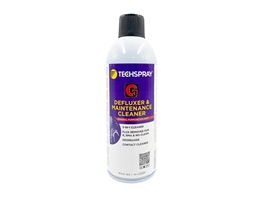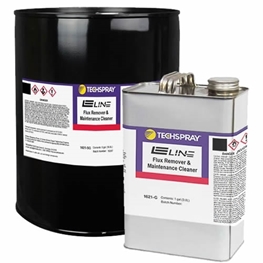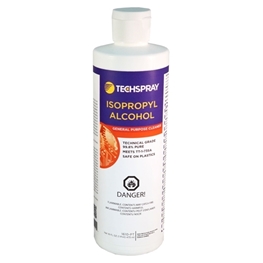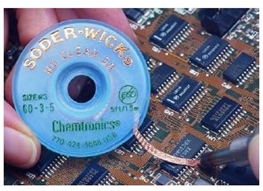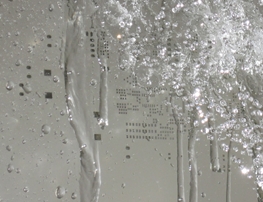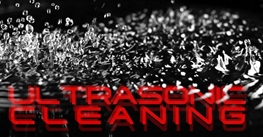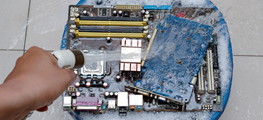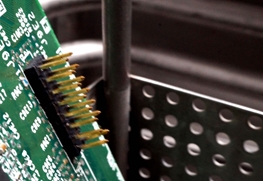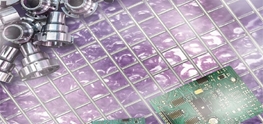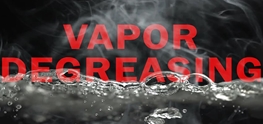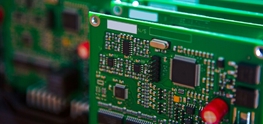Flux removers (defluxers) remove flux residues and other contaminants left by manufacture, rework, or repair of printed circuit boards. Residues from higher, lead-free temperatures are harder to clean. PWR-4, G3, E-LINE and Precision-V flux removers have been proven very effective at removing fluxes baked on at lead-free temperatures.
Micro-components and fine pitch leads are delicate and easily damaged, so brushing and scrubbing should be avoided if possible. The G3, E-LINE and Precision-V products have a powerful spray and strong solvent that blasts off residues and cleans areas under components that a brush cannot touch.
Techspray offers traditional solvent-based cleaners and cutting-edge water-based technologies marketed under the Techspray Renew brand.
Techspray Renew branded cleaners are innovative solutions that combine the best of current “green” technologies to make the most powerful eco-friendly cleaners on the market.
All Techspray flux removers have the following advantages:
- Help create bright, shiny solder joints
- Improve PCB reliability
- Prevent conformal coating defects
- Prevent corrosion from contamination
- RoHS compliant
Flammability
Plastic Sensitivity(Choose One)
Flux Type
Cleaning Method
Applied Filters
FAQ's
No, not if your concern is only reliability problems from ionic contamination. No-clean flux contains minimal ionic material that is fully consumed when the flux is activated, or in other words, brought to soldering temperature. If all of the flux isn’t activated, like when you apply a lot of flux but only solder a small area, you still need to clean the PCB. If you are applying conformal coating, you should remove all flux residues, regardless of the type of flux. Most people understand that when painting something, the surface must be prepared so it is absolutely clean. Otherwise, the paint will quickly lift off the surface and peel off. The same logic applies to conformal coating, even when the contamination is from no-clean flux.
The most common way to clean flux residues from a repair area is to saturate a cotton or foam swab with isopropyl alcohol or another cleaning solvent, and rub it around the repair area. While this may be adequate for no-clean flux, where the goal is a visually clean PCB, this may not be clean enough when more heavily activated fluxes are involved, like RA or aqueous. The dirty little secret is that flux residues will not evaporate along with the solvent. You may dissolve the flux, and some of the residues will soak into the swab, but most of the residues will settle back onto the board surface. Many times these white residues are more difficult to remove than the original flux. One quick and easy improvement to this process is to rinse the board after swabbing around the repair area. While the solvent is still wet, spray over the entire board with an aerosol flux cleaner. Hold the PCB at an angle to allow the solvent to flow over the board and run off, along with any residues that are picked up. The straw attachment that comes with aerosol flux removers is a good way to increase the spray force and penetrate under the components. Some aerosol flux removers come with a brush attachment. The cleaning solvent sprays through the brush, so agitation can be increased by scrubbing while spraying. To absorb the flux residues, a lint-free poly-cellulose wiper can be placed over the repair area, and the spraying and scrubbing can occur over the material. Then remove the wipe and brush attachment, and spray over the board for the final rinse.
Flux removers (defluxers) remove flux residues and other contaminants left by manufacture, rework, or repair of printed circuit boards. Flux removers can be solvent based (e.g. isopropyl alcohol) or water-based, which are generally used in batch or in-line cleaning systems.



